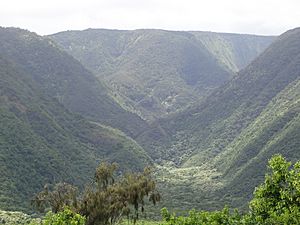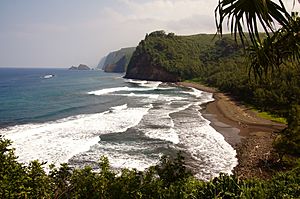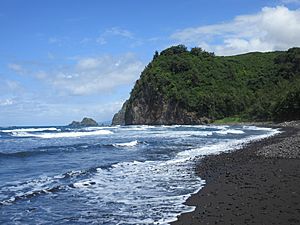Pololū Valley facts for kids
Pololū is a stunning valley located on the Island of Hawaiʻi. It's the northernmost of several valleys carved into the side of Kohala Mountain. The name Pololū comes from the Hawaiian language and means "long spear." This beautiful spot is known for its amazing views and natural features.
Contents
Exploring Pololū Valley's Natural Beauty
Pololū Valley is a deep cut into the side of Kohala Mountain. A stream called Pololū Stream flows through the entire valley. This stream helps shape the valley's landscape.
The Black Sand Beach
At the ocean side of the valley, you'll find a beautiful black sand beach. This unique beach is a popular spot for visitors. A yellow sand dune sits behind the beach. This dune helps protect the green areas further inland from strong ocean waves.
Hiking and Trails
Many Hiking trails wind through the valley. These trails allow people to explore its different parts. Some trails lead into the valley, while others climb out.
Pololū Valley's Interesting History
Long ago, before Europeans arrived, Pololū Valley was famous for its kalo (taro) farms. Kalo is a plant similar to a potato, and it was a very important food source. A special type of kalo, called kalo Pololū, grew here. It was known for its unique crimson (reddish-purple) stems.
Farming Through the Years
In the 1800s, farmers also grew rice in the valley. However, in the 1900s, the valley was used less for farming. Today, a part of the Kohala ditch runs along the sides of Pololū Valley. This ditch moves water from another valley to help sugarcane fields in the North Kohala district. Some companies even offer tours to hike along parts of this ditch.
Getting to Pololū Valley
You can reach Pololū Valley from the north. The journey ends at a lookout point at mile 28 on Highway 270. This highway is also known as Akoni Pule Highway. From the lookout, a fairly short hike on a well-kept trail leads you down into the valley. The trail doesn't stop there; it continues beyond Pololū Valley. It climbs over a ridge and leads to the next valley, called Honokane Nui Valley.





